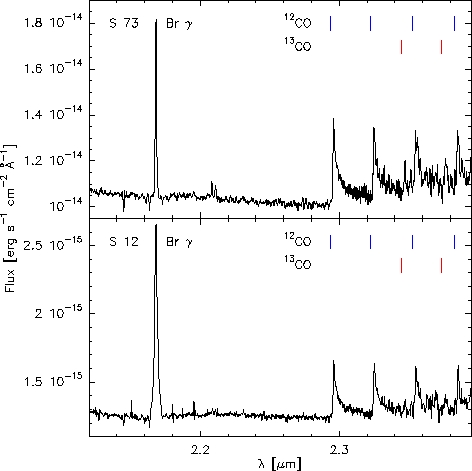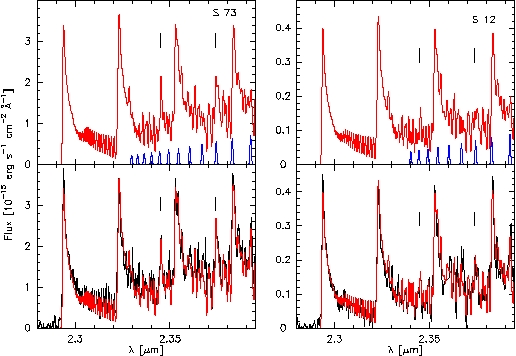
Starting from interstellar carbon isotope ratios, 13C becomes quickly enriched on the stellar surface already during the main-sequence evolution of the stars. At the end of the main-sequence, shown by the black dots, i.e. when the stars start to evolve into supergiants, the 12C/13C ratio has dropped to values below approximately 20. Such low ratios (i.e., high 13C enrichments) should be detectable in the wind and disk material around these stars. The best tracer of enriched 13C material is provided by the 13CO molecule. It is long known that B[e] supergiants' disks host molecules and dust, and strong CO band emission at near-infrared wavelengths has been reported for several of them in the literature. Thus the question arises whether 13CO bands will be detectable in these disks as well. To check this, we performed theoretical model calculations of the 12CO and 13CO band emission for different carbon isotope ratios. As can be seen in the following figure, the band heads of 13CO (their wavelengths are indicated by the blue ticks) start to show up in the total spectrum for a 12C/13C ratio of 20 (top panel) and clearly peak out of the spectrum for lower ratios, e.g. 5, as shown in the bottom panel. This means that we should definitely be able to observe any enrichment in 13C (and hence in 13CO) in the circumstellar material of massive evolved stars since this material has been released from the chemically enriched surfaces of the supergiant stars.

Using the Spectrograph for INtegral Field Observation in the Near-Infrared (SINFONI) attached to the 8m-telescope of the European Southern Observatory (ESO) at Paranal, Chile, we obtained high-quality K-band spectra for the two B[e] supergiants LHA 120-S 12 (in short: S12) and LHA 120-S 73 (in short: S73) in the LMC. Parts of their reduced and flux-calibrated spectra are shown in the following figure covering the Brackett gamma line of hydrogen (Br&gamma) and the first-overtone bands in both 12CO and 13CO. The wavelengths of the band heads are indicated by vertical ticks.

Signatures for 13CO is clearly present in the spectra of both stars. The proper modeling of the CO bands requires the inclusion of the Pfund series of Hydrogen. Although the Pfund lines turned out to have only a minor contribution to the total CO band spectra of these two stars (shown as the blue lines in the top panels of the next figure), they are nevertheless present. From a careful modeling of the combined 12CO and 13CO band spectra (red lines in the top panels of the following figure) we could reproduce the observed spectra reasonably well. This is obvious from the comparison of the final model spectra (red lines in the bottom panels) overplotted on the observations (black lines). The spectra of both B[e] supergiants contain a substantial amount of 13CO resulting in carbon isotope ratios 12C/13C of about 20 for S12 and about 9 for S73. This means that both stars are indeed evolved post-main sequence stars. The enrichment of their disk-forming wind material with 13C and the resulting strong 13CO band emission is thus shown to be a robust method for the identification of evolved stars. This result is encouriging because especially in our own Galaxy we know only of B[e] supergiant candidates. The search for 13CO in the K-band spectra of these candidates could thus, for the first time, definitely resolve the Galactic B[e] supergiant star population.

Finally, it is interesting to note that our modeling revealed that the CO gas in the disks of the two studied B[e] supergiants ist rather cool, less than 3000 K. This is surprising given that the CO band spectra are dominated by the hottest CO component. The lack of CO gas hotter than ~3000 K might thus hint towards a detached circumstellar gas shell rather than a continuously supplied equatorial disk-forming wind. Similar results have recently been reported for the B[e] supergiant S65 in the Small Magellanic Cloud.